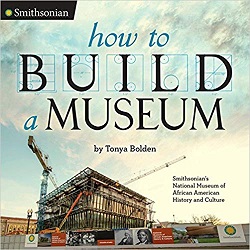
 How to Build a Museum
How to Build a MuseumSmithsonian’s National Museum of African American History and Culture
Smithsonian (Viking), 2016. 60 pages.
Starred Review
Review written in 2016
Here’s a beautiful book, published just in time to hit the gift shop of the National Museum of African American History. Here’s the complete Preface, which gives you an idea what to expect:
A museum is a treasure trove of things. Things lost then found. Things perennially prized. Objects once deemed worthless.
Whatever a museum collects – paintings, pottery, or playthings – its aim is the same: to safeguard remnants of history and culture that inspire, enlighten, and kindle the curiosity of the children and adults who come through its doors, generation after generation.
Smithsonian’s National Museum of African American History and Culture is a treasure trove of paintings, photographs, posters, playbills, pottery, documents, dolls, diaries, books, balls, bells, benches, medals, medallions, and more: objects that deepen our understanding of the black experience in America and so strengthen our grasp of American history.
This is the story of how that magnificent and monumental museum got built.
The first half of the book indeed describes how the museum came to be. The dream actually took shape 100 years ago, but only recently became an actual plan. Then the book tells about that planning process, including choosing a location – the last available space on the National Mall – and designing the building.
The second half of the book talks about the collections contained in the museum and their significance.
What makes this book wonderful is the abundance of photos – first of the building process, then of many items contained in the museum (and in some cases pictures showing how they got into the museum).
Reading this book has made me eager to visit the new museum, which opened only a few weeks ago. And now I have a better grasp of what I will see. This book is a nice overview for children’s and adults. It tells all that goes into building a museum as well as what you should look for in the finished museum.
